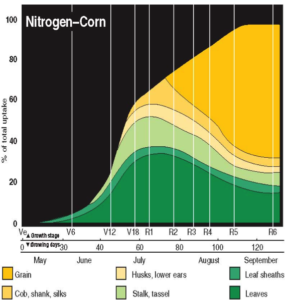No, it’s not a virus but it can be a self-inflicted ailment.
What is this affliction you might ask? Nitrogen deficiencies.
As we continue to push for higher yields – via narrower rows and higher populations – the stress we put on our nutrient supply systems continues to increase. Since N is one of the nutrients in highest demand, a high-yield year like this one, coupled with ample rainfall, can certainly test the mettle of your N application methods and amounts.
Nitrogen: In Review

Interestingly, this chart from the USDA indicates that we have not really increased our N applications much in the last 30 years, even though our yields have nearly doubled during that time. This is likely due to costs, environmental concerns, as well as our ability to manage more efficiently. New research is also indicating that modern hybrids are more efficient at utilizing N.
So if we are increasing our yields dramatically but not adding much N, what can happen in a year such as 2014 when we have ample to excessive rain and a large crop? Yellow fever – or N deficiencies.
Solving the Nitrogen Deficiency Equation
What can be done about the situation?

- Continue to search for technologies that slow or reduce denitrification or volatilization of N (such as advanced fertilizer technology)
- Utilize equipment that may allow growers an extended application window – applying much later in the growing season.
By delaying our applications we accomplish a number of things:
- Place the N closer to the time when the plant is still using large amounts of N
- Ability to adjust our rates based on the growing season. If we have a great crop and great conditions it would be wise to adjust our rates accordingly.
- Be more environmentally friendly by reducing large applications in the fall or early spring exposing them to denitrification and leaching.
Changes Ahead for Nitrogen Application
So what can we do moving forward? As the price of N continues to climb, growers will need to continue to upgrade their management systems in order to apply the N as late in the growing season as possible.
Currently much of the N that is side-dressed is applied in the V4-V6 stage. Unfortunately at the V6 stage a corn plant still needs the vast majority of the N required to make a crop, as a plant uses half of its N after tassel. So, if we have heavy rains after this application, we still lose much of the N due to denitrification and leaching.